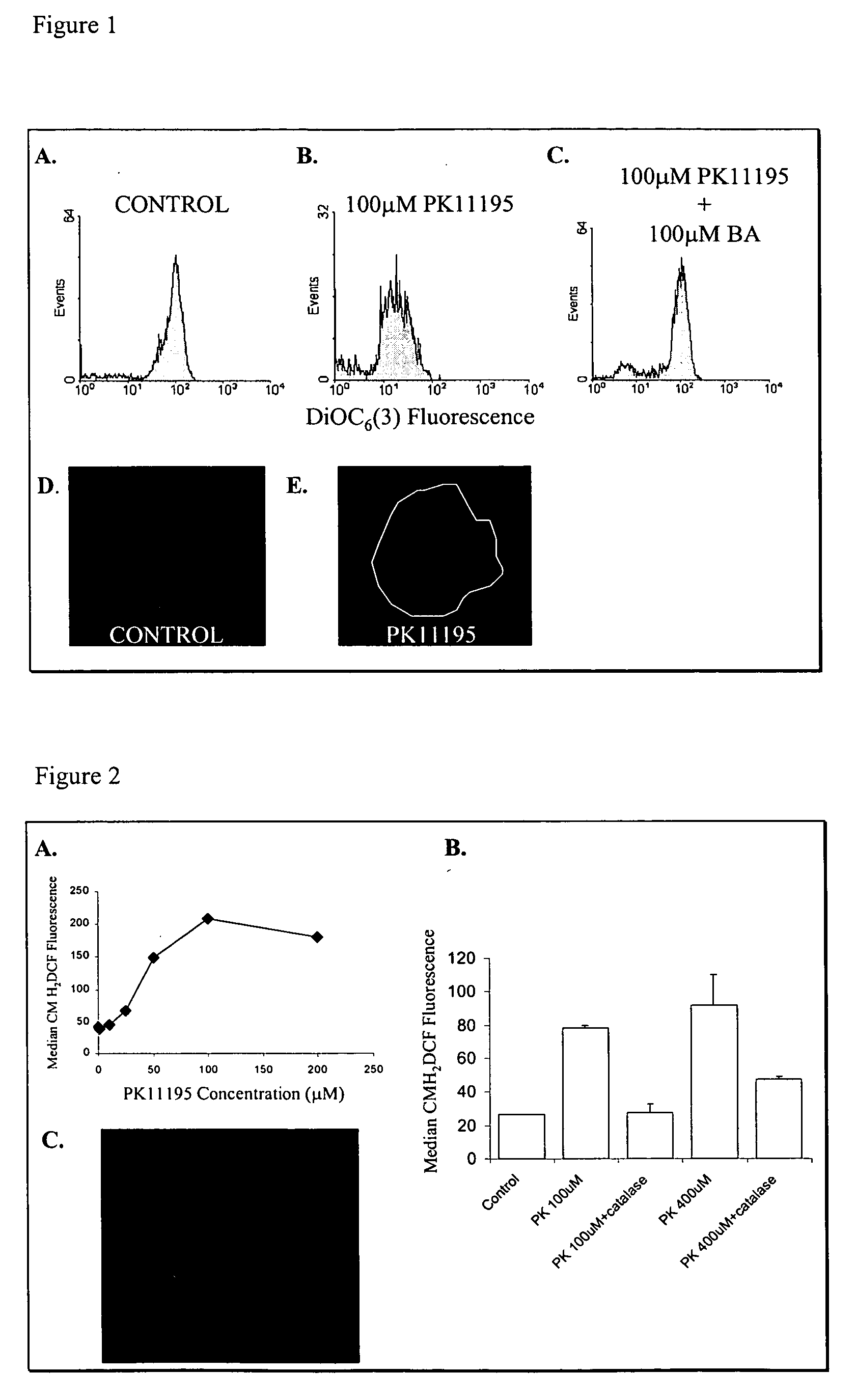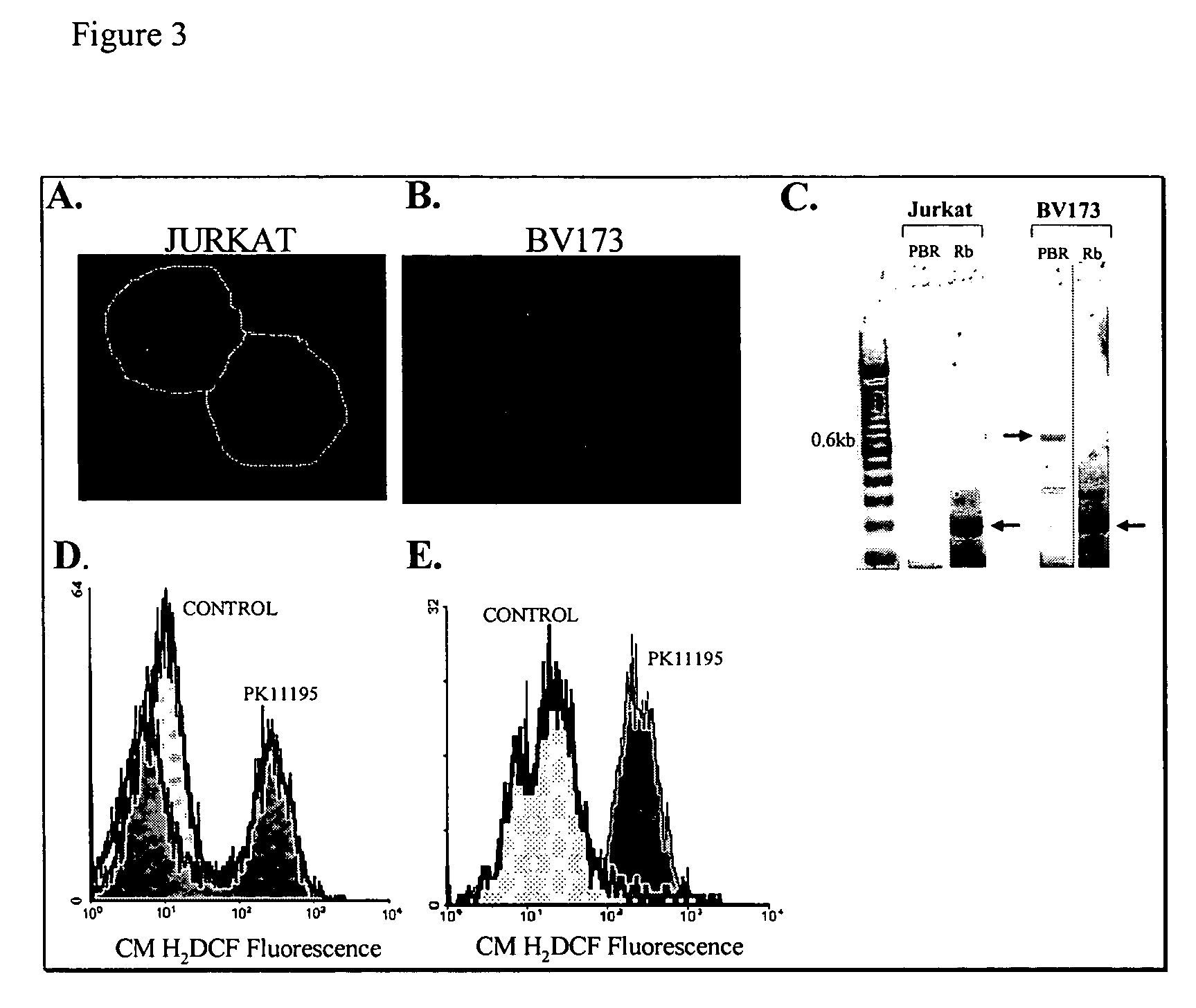Peripheral benzodiazepine receptor independent superoxide generation
a technology of benzodiazepine receptor and superoxide, which is applied in the direction of peptides, biological material analysis, drug compositions, etc., can solve the problems of frustrated attempts to capitalize, and achieve the effect of antagonizing the anti-death activity
- Summary
- Abstract
- Description
- Claims
- Application Information
AI Technical Summary
Benefits of technology
Problems solved by technology
Method used
Image
Examples
example 1
PK11195 Directly Induces BA Inhibitable MPT in HL60 Leukemic Cells.
[0072] HL60 leukaemia cells treated with PK11195 exhibited a reduction in DiOC6(3) fluorescence (FIG. 1B) detectable within 3 hours compared with control (FIG. 1A), consistent with collapse of mitochondrial ΔΨm. The ANT specific inhibitor BA prevented PK11195 mediated mitochondrial depolarisation (FIG. 1C), implicating the ANT in the process of PK11195 induced reduction in DiOC6(3) fluorescence. Mitochondrial calcein fluorescence was quenched by PK11195 consistent with mitochondrial equilibration with cytosolic cobalt via open PTPCs (FIGS. 1D and 1E). Calcein quenching was not observed in BA treated cells (not shown).
example 2
Dose Dependent Hydrogen Peroxide Generation Mediated by PK11195 is Localised to Mitochondria.
[0073] CMH2DCF fluorescence in HL60 cells increased in a PK11195 concentration dependent manner, occurring in a 50-100 micromolar range of concentrations (FIG. 1A), consistent with the generation of ROS (FIG. 2A). This increase in CMH2DCF fluorescence was inhibited in cells treated with catalase consistent with hydrogen peroxide dependent oxidation mediated by PK11195 (FIG. 2B). Fluorescence microscopy of CMH2DCFDA loaded HL60 cells demonstrated a punctate cytoplasmic distribution of H202 generation following PK11195 treatment (FIG. 2C); this co-localised with that of the potentiometric probe CMX-Rosamine, consistent with mitochondrial generation of H202.
example 3
The PBR is not Involved in PK11195 Induced H202 Generation.
[0074] To determine the involvement of the PBR in PK11195 mediated ROS, generation of H202 was investigated in cell lines with differential PBR expression. The Jurkat T cell leukaemia line has previously been shown to be devoid of PBR expression. This was demonstrated via the absence of NBD FGIN-1-27 analogue binding observed by fluorescence microscopy (FIG. 3A). In contrast, BV173 leukaemia cells exhibited strongly positive staining of NBD FGIN-1-27 analogue, with a distinct punctate cytoplasmic distribution (FIG. 3B). Consistent with these findings, expression of the PBR was identified by RT-PCR in BV173 cells but not Jurkat cells (FIG. 3C). Irrespective of PBR expression however, PK11195 treatment produced an increase in CMH2DCF fluorescence in both BV173 and Jurkat cells consistent with generation of H202 (FIGS. 3D and 3E).
PUM
| Property | Measurement | Unit |
|---|---|---|
| time | aaaaa | aaaaa |
| time | aaaaa | aaaaa |
| time | aaaaa | aaaaa |
Abstract
Description
Claims
Application Information
 Login to View More
Login to View More - R&D
- Intellectual Property
- Life Sciences
- Materials
- Tech Scout
- Unparalleled Data Quality
- Higher Quality Content
- 60% Fewer Hallucinations
Browse by: Latest US Patents, China's latest patents, Technical Efficacy Thesaurus, Application Domain, Technology Topic, Popular Technical Reports.
© 2025 PatSnap. All rights reserved.Legal|Privacy policy|Modern Slavery Act Transparency Statement|Sitemap|About US| Contact US: help@patsnap.com



